By Sophie Hadden (MSc Museum Studies)
For four months I have been working on placement in Special Collections as part of my postgraduate MSc in Museum Studies. I was tasked with the cleaning, rehousing and listing of the Jessie M. King/E. A. Taylor photo collection.
The collection was purchased by Special Collections in 1986 as part of the papers of artist Jessie M. King and her husband E. A. Taylor. The papers have since been listed in detail and individual item descriptions can be viewed on the Special Collections website (MS Gen 1654).The photo collection, however, had never been listed and was accessible online through only a brief description. The one sentence summary did not give any indication of the diversity of the collection, which consists of over 500 photographs dating from the late nineteenth and early twentieth centuries. Through the process of cleaning, rehousing and listings I was to develop an understanding of the collection and its content so that it could be made more accessible and better publicised. For example, the description for the photo collection has now been extended to give a clearer idea of the contents (Photo A56).
The collection was originally housed in 8 boxes of varying size and the nature of these boxes meant that the photographs required a lot of handling to be viewed. My first step to improving the storage of the photographs was to clean them. Working in Conservation I cleaned each photo individually, removing dust and dirt with a soft-hair brush or eraser. The majority of the photographs were relatively clean but several, particularly the oldest portraits, required more intensive cleaning.
Once the photos had been cleaned they were given an individual number and rehoused in polyester pockets and ring binder boxes. This new housing means that the photographs are not only much easier to browse through but they no longer need to be handled when viewed.
After rehousing the photographs each was given an individual description as part of a comprehensive list that can be made available to anyone with an interest in the collection. It was through this process of listing that I became most familiar with the collection and developed an impression of Jessie M. King and E. A. Taylor whose lives and personalities are reflected throughout the collection.
Jessie Marion King was born in Glasgow in 1875 and attended the Glasgow School of Art between 1892 and 1899. She is considered one of the most influential Scottish artists of her time and is certainly the most commercially successful. Her career began in 1899 when she was commissioned by the owner of a Berlin department store to design wallpaper, wrapping paper and a series of book covers. It is perhaps for her illustration work that King is most celebrated (Photo A56/ 486-494) but her long and productive career included painting, jewellery and ceramic design, fabrics and costumes. She was instrumental in introducing the wax-dye technique of batik to Scotland (Photo A56/87) and sold scarf designs to Liberty’s of London. She also produced a book titled How to make your own Batik in 1924 and several press cuttings about the book can be found in the papers collection (MS Gen 1654/471, 474, 477, 478).
While examples of her work are visible in the collection it is of King herself that the photographs offer the best insight. All accounts describe King as a sociable extrovert, quick to laugh and unique in both style and talent. This is clearly reflected in photographs of King that show her always tied-up hair, wide brimmed hats, eccentric clothes and often wearing a scarf of her own design. Her smile can only be described as mischievous and she is seen often laughing with friends and family.
E. A. Taylor, by contrast, seems a far more serious character. Born in 1874, Ernest Archibald Taylor (E. A. or Ern to his friends) worked in furniture design and stained glass but also had a passion for watercolours and oil painting. A number of his designs were exhibited at the Glasgow International Exhibition in 1901 and in Budapest and Turin in 1902. He and King met whilst he was taking evening classes at the School of Art and became engaged in 1898 although they did not marry until 1908. Taylor appears less frequently than King throughout the collection in candid shots but there are a significant number of formal portraits, taken throughout his life. This perhaps matches descriptions of Taylor as a sophisticated figure who was respected as an authority on design by his peers.
However, several photographs offer a glimpse of a more playful side to Taylor. One photo shows Taylor posing with flowers in his hair and an amused looking Merle (Photo A56/363) while a strip of passport photos show him striking various poses, ubiquitous hat both on and off! (Photo A56/395) The overall impression gained from the collection is of a well-matched pair whose passion for art, friendship and, most significantly, their daughter shine through.
Taylor and King also shared a passion for teaching. King taught Book Design at the School of Art and when the couple moved to Paris in 1910 they established the Shealing Atelier of Oil and Watercolour Painting, Design and the Applied Arts. Whilst in Paris Taylor also taught both women’s and men’s classes at the School of Drawing and Painting (4 programmes for winter classes can be found in the archival material that was housed among the collection).
After leaving Paris following the outbreak of the First World War, Taylor and King settled at the Green Gate in Kirkcudbright where they established a studio at Green Gate Close which became an important centre for female artists. The couple were widely respected in the artist community and the head of painting at the Edinburgh College of Art once said that no artist could consider their training complete until they had learned from the Taylors at Green Gate. Indeed several notable artists from the period appear in the collection including Dorothy Johnston and Anna Hotchkis (Photo A56/223) and sculptor H. S. Gamley (Photo A56/418).
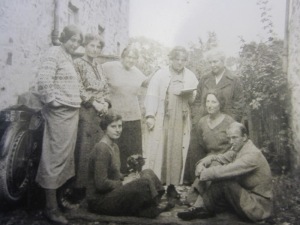
The Artist of Green Gate Close, c 1925 including Jessie M King (standing third from right), Anna Hotchkis and Dorothy Johnston (seated). (Photo A56/223)
Another interest that the couple shared was for the organising, designing and taking part in historical pageants. Photographs of individuals dressed in pageant costumes are littered throughout the collection. Particularly impressive is Box G which contains some 59 pageant portraits from a portfolio, put together by Annan of Glasgow, and gifted to King to commemorate her contribution to the 1908 Scottish National Historical Pageant for which she designed some thirty costumes in the theme of Arthurian legend. King and Taylor can both be seen taking part, dressed as “Sir Perceval” and “The Holy Graal” respectively (Photo A56/546).
Through the process of cleaning, rehousing and listing the Jessie M. King/ E. A. Taylor collection over the last four months I have developed an appreciation for its value. It may not be a significant example of photography from the period and it does not contain any examples of King or Taylor’s work that could not be found elsewhere. What it does provide is a unique and very personal insight into the lives of two fascinating Scottish artists, particularly King, and the contribution she made to the art community.
For more on Jessie M. King and E. A. Taylor see:
Burkhauser, J. (1990), ‘Jessie M. King’, in J. Burkhauser (ed.), Glasgow Girls: women in art and design 1880-1920, Edinburgh, 132-139.
White, C. (1989), The Enchanted World of Jessie M. King, Edinburgh.
Categories: Special Collections
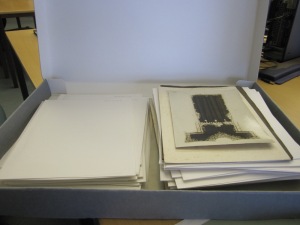
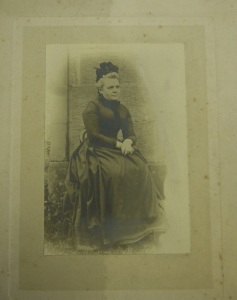
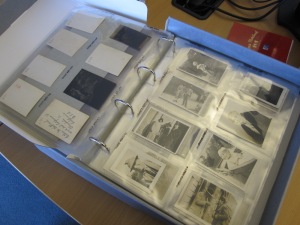
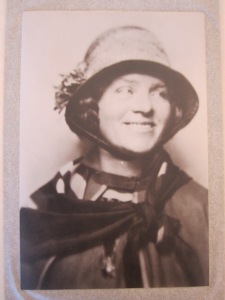
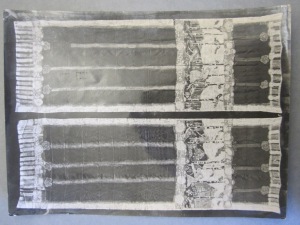
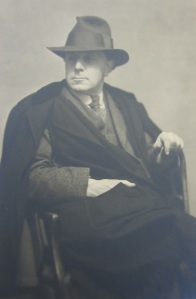
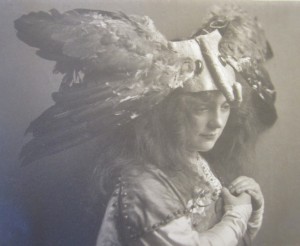
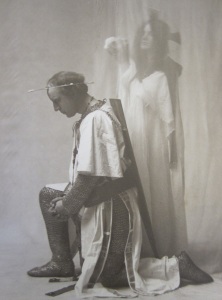
 Johnny Beattie: ‘The Clown Prince of Scotland’
Johnny Beattie: ‘The Clown Prince of Scotland’  The Arte of Faire Writing
The Arte of Faire Writing  Visualizing Collation in the Hunterian Manuscript Collection
Visualizing Collation in the Hunterian Manuscript Collection  Sugar Machines: How Archives in Glasgow hold pieces of Caribbean History
Sugar Machines: How Archives in Glasgow hold pieces of Caribbean History
Leave a comment